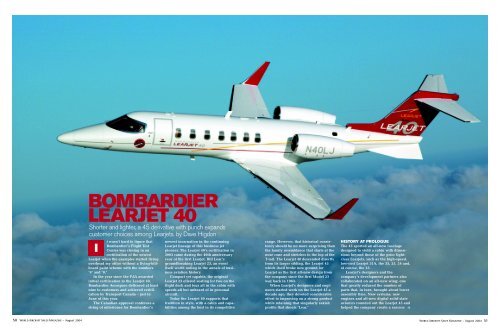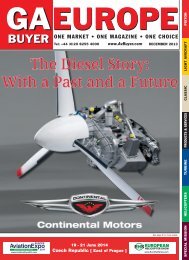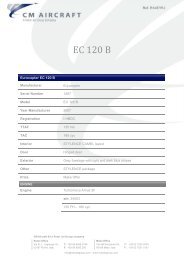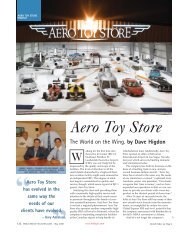BOMBARDIER LEARJET 40 - AvBuyer.com
BOMBARDIER LEARJET 40 - AvBuyer.com
BOMBARDIER LEARJET 40 - AvBuyer.com
You also want an ePaper? Increase the reach of your titles
YUMPU automatically turns print PDFs into web optimized ePapers that Google loves.
50 WORLD AIRCRAFT SALES MAGAZINE – August 2004<br />
<strong>BOMBARDIER</strong><br />
<strong>LEARJET</strong> <strong>40</strong><br />
Shorter and lighter, a 45 derivative with punch expands<br />
customer choices among Learjets. by Dave Higdon<br />
I<br />
t wasn’t hard to figure that<br />
Bombardier’s Flight Test<br />
Center was closing in on<br />
certification of the newest<br />
Learjet when the examples started flying<br />
overhead my office without a flying-billboard<br />
paint scheme with the numbers<br />
"4" and "0."<br />
In the year since the FAA awarded<br />
initial certification to the Learjet <strong>40</strong>,<br />
Bombardier Aerospace delivered at least<br />
nine to customers and achieved certification<br />
by Transport Canada – just in<br />
June of this year.<br />
The Canadian approval continues a<br />
string of milestones for Bombardier’s<br />
newest incarnation in the continuing<br />
Learjet lineage of this business jet<br />
pioneer. The Learjet <strong>40</strong>’s certification in<br />
2003 came during the <strong>40</strong>th anniversary<br />
year of the first Learjet, Bill Lear’s<br />
groundbreaking Learjet 23, an event<br />
itself worth noting in the annals of business<br />
aviation history.<br />
Compact yet capable, the original<br />
Learjet 23 offered seating for two on the<br />
flight deck and four aft in the cabin with<br />
speeds all but unheard of in personal<br />
aircraft.<br />
Today the Learjet <strong>40</strong> supports that<br />
tradition in style, with a cabin and capabilities<br />
among the best in its <strong>com</strong>petitive<br />
range. However, that historical consistency<br />
should be no more surprising than<br />
the family resemblance that starts at the<br />
nose cone and stretches to the top of the<br />
T-tail. The Learjet <strong>40</strong> descended directly<br />
from its larger sibling, the Learjet 45<br />
which itself broke new ground for<br />
Learjet as the first all-new design from<br />
the <strong>com</strong>pany since the first Model 23<br />
way back in 1963.<br />
When Learjet’s designers and engineers<br />
started work on the Learjet 45 a<br />
decade ago, they devoted considerable<br />
effort to improving on a strong product<br />
while retaining that singularly rakish<br />
profile that shouts "Lear."<br />
HISTORY AT PROLOGUE<br />
The 45 sported an all-new fuselage<br />
designed to yield a cabin with dimensions<br />
beyond those of the prior lightclass<br />
Learjets, such as the high-speed,<br />
low-cost Learjet 31A, the 35, 25, 24 and,<br />
of course, the 23.<br />
Learjet’s designers and the<br />
<strong>com</strong>pany’s development partners also<br />
collaborated on an all-new wing; one<br />
that greatly reduced the number of<br />
parts that, in turn, brought about lower<br />
assembly time. New systems, new<br />
engines and all-new digital solid-state<br />
avionics rounded out the Learjet 45 and<br />
helped the <strong>com</strong>pany create a success ✈<br />
WORLD AIRCRAFT SALES MAGAZINE – August 2004 51
<strong>BOMBARDIER</strong> <strong>LEARJET</strong> <strong>40</strong> UPDATE 2<br />
that already numbers more than 2<strong>40</strong> flying.<br />
Still, not every jet achieves its<br />
maximum potential in its original form;<br />
many evolve into one or more larger<br />
variants to answer market demand.<br />
MOVING UP BY DOWNSIZING:<br />
Such an evolution befell the Learjet 45 –<br />
but in this case the market wanted something<br />
less. To answer market demand for<br />
a smaller, lighter, less-expensive Learjet,<br />
Bombardier Aerospace approved a<br />
different tact in model expansion, opting<br />
to grow the product lineup larger by<br />
shrinking the Model 45.<br />
Yes, that shrinkage is the biggest<br />
difference between the Learjet <strong>40</strong> and its<br />
progenitor, the Learjet 45. Pretty much<br />
everyone with time in business aviation<br />
recognizes the benefits of "stretching" one<br />
model to make a new one. Shrinking a<br />
successful model to make a new one<br />
happens less often, but the Learjet <strong>40</strong> is<br />
proof positive that it can and does happen<br />
– and for good cause: Costs – cost of entry<br />
and cost of operation.<br />
Furthermore, when a manufacturer<br />
leaves well enough alone – or makes<br />
changes that keep both models uniform –<br />
those changes can also help drive down<br />
manufacturing costs. In the case of the<br />
Learjet <strong>40</strong>, it appears Bombardier<br />
Aerospace hit its marks.<br />
COMMONALITIES:<br />
To make the Learjet <strong>40</strong> out of the Learjet<br />
45, Bombardier’s engineers essentially<br />
did nothing more than take out two feet<br />
of fuselage and position the wing accordingly.<br />
This change gives the Learjet <strong>40</strong> a<br />
overall length of 55.6 feet versus 58.4 feet<br />
for the Learjet 45.<br />
Internally, the Learjet <strong>40</strong> stretches 17.7<br />
feet inside the cabin, two feet shorter than<br />
the Learjet 45. But both models’ cabins<br />
share their other dimensions, at 4.9 feet<br />
tall and 5.1 feet across. Both airplanes<br />
otherwise share the same wing, engines,<br />
avionics, pretty much the works<br />
throughout the airplane.<br />
The same Honeywell Primus 1000 integrated<br />
flight-display and flight-control<br />
hardware fills the cockpits of both aircraft.<br />
That sharing also necessarily includes the<br />
powerplants, with the Learjet <strong>40</strong> employing<br />
a pair of Honeywell TFE731-20AR, each<br />
making 3,500 pounds of thrust – the same<br />
power output as on the Learjet 45.<br />
With both airplanes certified to a<br />
maximum altitude of 51,000 feet, both are<br />
capable of cruising at Mach 0.81, and the<br />
Learjet <strong>40</strong> able to cover more than 1,700<br />
miles non-stop, versus about 1,800 for the<br />
Learjet 45. However, the couple of<br />
hundred pounds difference in empty and<br />
operating weights does take its toll up at<br />
the flight levels where these birds<br />
perform their best.<br />
ECONOMIES OF SCALE:<br />
Loaded to the max, the Learjets <strong>40</strong> and 45<br />
tip the scales within 150 pounds of one<br />
another – with the Learjet 45 capable of<br />
carrying more fuel and/or more people<br />
than the Learjet <strong>40</strong>. Nevertheless, these<br />
differences don’t work to produce any<br />
noteworthy differences in the balance<br />
between cabin payload and fuel, in<br />
cruise, climb or consumption numbers. In<br />
fact, so similar are the performance<br />
numbers that it’s almost a waste of space<br />
to highlight any, as you may have noticed<br />
above.<br />
52 WORLD AIRCRAFT SALES MAGAZINE – August 2004 www.<strong>AvBuyer</strong>.<strong>com</strong><br />
Aircraft Index see Page 2<br />
✈
<strong>BOMBARDIER</strong> <strong>LEARJET</strong> <strong>40</strong> UPDATE 3<br />
Flying with four passengers, a crew of<br />
two and allowable fuel, the Learjet <strong>40</strong><br />
can fly more than 1,600 nautical miles<br />
on a bit under 4,100 pounds of fuel.<br />
Similarly, the Learjet 45 can, with the<br />
same four passengers and bags, cover a<br />
couple hundred miles more –due solely<br />
to a larger fuel capacity. It takes the<br />
Learjet 45 more than 4,600 pounds of<br />
fuel to cover those 1,800-plus nautical<br />
miles – but the specific fuel consumption<br />
numbers are nearly identical, within<br />
0.003 pounds per mile of one another.<br />
So, what is the gain of the smaller<br />
bird? How about nearly $2.5 million<br />
difference: The Learjet <strong>40</strong>, <strong>com</strong>parably<br />
equipped, goes for about $7.8 million,<br />
<strong>com</strong>pared to just over $10.2 million for<br />
the Learjet 45.<br />
For a fleet operator flying Learjet 45s,<br />
the Learjet <strong>40</strong> offers a smaller, lowercost,<br />
just-as-capable alternative for a<br />
second plane – and one that shares the<br />
same type rating, a boon to training<br />
costs. Maintenance issues also cost less<br />
when a shop has two jets with identical<br />
engines, nacelles, wings, gear, avionics,<br />
environmental and auxiliary systems.<br />
A <strong>com</strong>pany can get in a lot of flying<br />
on the price difference alone. As a new<br />
option for business jet shoppers, the<br />
Learjet <strong>40</strong> fills a gap between the Learjet<br />
45 and contenders made by other planemakers<br />
- and buyers seldom <strong>com</strong>plain<br />
about excess choices.<br />
FURTHER EVOLUTION:<br />
With certification of the new Honeywell<br />
TFE731-20BR engine secured in late<br />
June, Learjet should soon start delivering<br />
the second new derivative of the<br />
Learjet 45 – the 45 XR.<br />
Again sharing practically every<br />
system and <strong>com</strong>ponent – aside from<br />
minor differences in the engine – the<br />
Learjet 45 XR offers operators longer<br />
range, speedier climb and, thanks to the<br />
new engines, hot-and-high performance<br />
almost 1,000 miles better than the original<br />
Learjet 45.<br />
The Honeywell TFE731-20BR engine<br />
can make its full 3,500 pounds of thrust<br />
at ISA+25 degrees Celsius, a full 9<br />
degrees higher than the TFE731-20AR<br />
<strong>LEARJET</strong> <strong>40</strong> <strong>LEARJET</strong> 45 <strong>LEARJET</strong> 45 XR<br />
DIMENSIONS<br />
Length ..........................55.5 ft .......................57.6 ft.....................57.6 ft<br />
Height...........................14.1 ft .......................14.1 ft....................14.1 ft<br />
Wing Span ..................47.8 ft ........................47.8 ft.....................47.8 ft<br />
INTERIOR<br />
Length ..........................17.7 ft ........................19.5 ft....................19.5 ft<br />
Height...........................4.9 ft..........................4.9 ft ......................4.9 ft<br />
Width.............................5.1 ft..........................5.1 ft ......................5.1 ft<br />
POWER<br />
Engines........................2x Honeywell .........2x Honeywell.......2x Honeywell<br />
TFE731-20AR........TFE731-20AR ....TFE731-20BR<br />
Thrust ...........................3,500lbs...................3,500lbs ...............3,500lbs<br />
AVIONICS ................Honeywell................Honeywell ............Honeywell<br />
Primus 1000...........Primus 1000 .......Primus 1000<br />
WEIGHTS<br />
MTOW ...........................20,350 lbs...............20,500 lbs...........21,500 lbs<br />
Max Landing ..............19,200 lbs...............19,200 lbs ...........19,200 lbs<br />
Max Payload ..............2,572 lbs..................2,271 lbs..............2,271 lbs<br />
Useful Load................-...................................- ...............................-<br />
Max Fuel......................5,375 lbs..................6,062 lbs..............6,062 lbs<br />
AIRPORT PERFORMANCE<br />
Take-Off.......................-...................................- ...............................-<br />
Landing ........................2,660 ft ....................2,660 ft.................2,660 ft<br />
CRUISE PERFORMANCE<br />
High Speed................0.81 mach ...............0.81 mach............0.81 mach<br />
Long Range................0.75 mach ...............0.75 mach............0.75 mach<br />
Range ...........................1,700nm...................1,800nm...............2,000nm<br />
CAPACITY<br />
Flight Crew.................2 .................................2..............................2<br />
Passengers................7 .................................9..............................9<br />
Projected Price .........$7.8m........................$10.2m.................$10.85m<br />
Note: These statistics are posted on www.aero.bombardier.<strong>com</strong><br />
that power the Learjets 45 and <strong>40</strong>.<br />
The 45 XR boasts a landing-gear<br />
improvement to handle a gross take-off<br />
weight of 21,500 pounds, exactly 1,000<br />
pounds higher than the Learjet 45. With<br />
more than 600 pounds of that higher<br />
weight available in fuel – and thanks to<br />
the higher elevations at which the<br />
engines can make full power – the<br />
Learjet 45 XR with eight passengers can<br />
fly almost 1,000 miles farther than the<br />
Learjet 45 <strong>com</strong>ing out of a high-elevation<br />
locale like Aspen, Colorado.<br />
With full fuel, the Learjet 45 XR can<br />
still carry eight in the cabin and cover<br />
more than 2,000 nautical miles, nonstop.<br />
So even though the Learjet 45 XR<br />
is dimensionally the same as the Learjet<br />
45, even with the same thrust, the XR is<br />
arguably an example of getting something<br />
more – for practically nothing.<br />
In this case, the "nothing" equates to<br />
about $600,000, the price difference<br />
between the Learjet 45 and the $10.85<br />
million price tag of the Learjet 45 XR.<br />
■ More information from Bombardier Aerospace;<br />
Website: www.aero.bombardier.<strong>com</strong><br />
54 WORLD AIRCRAFT SALES MAGAZINE – August 2004 www.<strong>AvBuyer</strong>.<strong>com</strong><br />
Aircraft Index see Page 2






